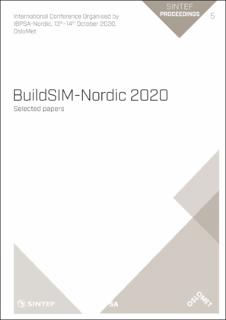| dc.contributor.author | Tuniki, Himanshu Patel | |
| dc.contributor.author | Jurelionis, Andrius | |
| dc.contributor.author | Dobrovolskytė, Monika | |
| dc.date.accessioned | 2020-10-21T07:30:11Z | |
| dc.date.available | 2020-10-21T07:30:11Z | |
| dc.date.issued | 2020 | |
| dc.identifier.isbn | 978-82-536-1679-7 | |
| dc.identifier.issn | 2387-4295 | |
| dc.identifier.uri | https://hdl.handle.net/11250/2684054 | |
| dc.description.abstract | The predicted percentage of dissatisfied (PPD) value indicates the percentage of people dissatisfied with thermal environment, as it depends not only on the environment itself, but on physical, psychological, or behavioural aspects as well. Flexible and adaptive occupant behaviour provides more opportunities for both reaching higher perceived levels of comfort and energy savings. In this research, the software simulation tool IDA-ICE has been used to analyse the building performance of the office building under two scenarios, an adaptive case, and a non-adaptive case. One pattern was based on standard clothing levels, while the other dealt with the possibility for the occupants to adjust in terms of clothing and window operation with respect to the air temperature. The analysis was based on the concept that coping with dissatisfaction can be linked to lower PPD values, and adaptive models can be incorporated into dynamic building energy performance simulations. The results show that there are noticeable differences in the energy used per m2, cooling and thermal dissatisfaction, upon adopting adaptive approach with respect to clothing, Predicted Mean Vote (PMV) value and the window opening behaviour. Certain occupant behaviours aimed at maintaining thermal comfort that can both increase the accuracy of energy performance predictions and lead to increased energy savings in office buildings. | en_US |
| dc.language.iso | eng | en_US |
| dc.publisher | SINTEF Academic Press | en_US |
| dc.relation.ispartof | International Conference Organised by IBPSA-Nordic, 13th - 14th October 2020, OsloMet. BuildSIM-Nordic 2020. Selected papers | |
| dc.relation.ispartofseries | SINTEF Proceedings;5 | |
| dc.rights | CC-BY-NC-ND | * |
| dc.rights.uri | http://creativecommons.org/licenses/by-nc-nd/4.0/deed.no | * |
| dc.title | Energy performance of an office building by using adaptive approach to occupant behaviour and environment control | en_US |
| dc.type | Chapter | en_US |
| dc.type | Peer reviewed | en_US |
| dc.description.version | publishedVersion | en_US |
| dc.rights.holder | © The authors. Published by SINTEF Academic Press 2020
This is an open access publication under the CC BY-NC-ND license (http://creativecommons.org/licenses/by-nc-nd/4.0/). | en_US |
| dc.subject.nsi | VDP::Teknologi: 500 | en_US |
| dc.source.pagenumber | 238-243 | en_US |

